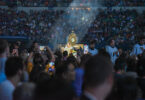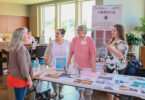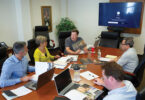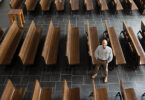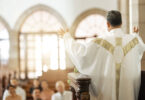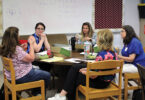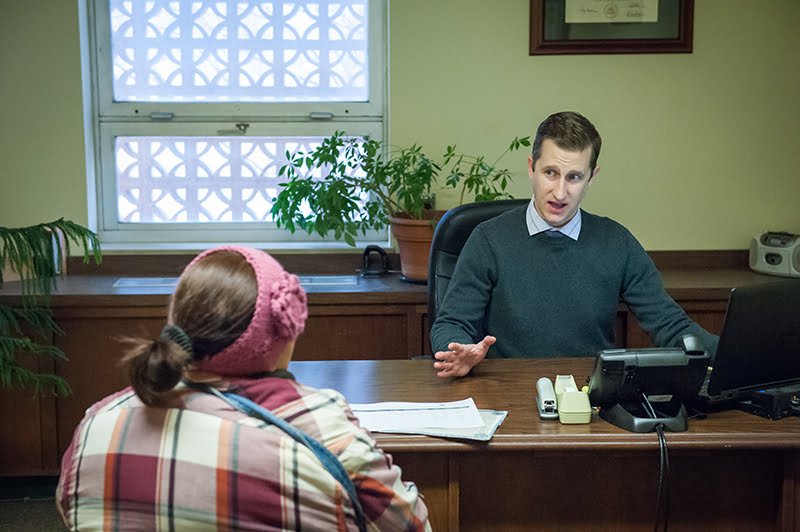
Immigration lawyer Greg Bole talks with a client at the La Luz Center for Immigration Legal Assistance, operated by Catholic Charities of Northeast Kansas. Bole looks for ways to help immigrants stay in the United States. LEAVEN PHOTO BY LORI WOOD HABIGER
by Doug Weller
Special to The Leaven
Kansas City, Kan. — Talk in the nation’s capital of clamping down on illegal immigration and deporting people who don’t have legal documentation has Greg Bole scrambling.
On Wednesday mornings, the day the lawyer opens the La Luz Center for Immigration Legal Assistance to anyone who wants to talk to him, upwards of 50 people crowd the reception area to learn if they have any legal options to stay in the country.
“There are a lot of anti-immigration voices right now,” said Bole, who specializes in immigration law at the center operated by Catholic Charities of Northeast Kansas.
“With immigration law, you are looking to see if you can fit someone in a legal category, to see if they qualify,” he said. Most, however, don’t have a legal avenue.
The anti-immigration sentiment often is heard among Catholics, Bole acknowledged, and he frequently finds himself explaining why the Catholic Church is involved in the issue.
“I try to emphasize that the pope and the archbishop and the Catholic Church generally tend to take a pro-immigration, pro-refugee stance. But what we don’t do is work outside the law,” he stressed.
One needs only to read Scripture to learn why the Catholic Church does what it does, said Rachel Pollock, director of Catholic Charities’ refugee and immigration programs, which opened the La Luz Center at 2220 Central Avenue in Kansas City, Kansas, in 2010.
“I grew up in the church and felt like it was modeled to me by Scripture and the people I looked up to. Compassion — welcoming the stranger — was ingrained in me,” she said.
Once you hear why people are in this country, it’s difficult not to feel compassion, she added.
“I listen to their stories and imagine, ‘What if I were on the other side? What type of mercy and love would I want to see?’” she continued.
“In the tradition of Jesus, I want to treat everyone personally as if it was Jesus himself,” she explained.
The U.S. Conference of Catholic Bishops offers details on church policy on its website at: justiceforimmigrants.org. It explains the church’s principles on migration, why people leave their native countries and what Catholics can do to help.
The Archdiocese of Kansas City in Kansas has been involved in immigration and refugee assistance since 1980, Pollock said.
As with any controversial issue, she noted, people need to educate themselves to better understand the complexity of immigration.
“When you don’t have contact with people who are immigrants or refugees, I understand why people feel scared,” she said. “It just changes once you start meeting people, hearing their stories. You would make the decisions they did. Everyone is just trying to survive and provide for their kids.”
Most of Bole’s work at La Luz involves working with people who came here from Mexico or Central America, although it runs the gamut. Recent clients have included a Burmese woman admitted to the United States as a refugee who became a citizen and a Kenyan man who was able to obtain legal residency because he was victimized by his U.S. spouse.
“I tell people to come see me first. We’ll go over their personal information and their options . . . what needs to be done to begin the process,” Bole said.
People’s options are based on how they got to the United States.
“Broadly defined, an immigrant is anyone who has come from a new country for any reason: better opportunities for their kids, education, to reunite with family, get married,” Pollock said. “A refugee is someone who has been granted access to this country because of specific reasons, such as persecution.”
A refugee automatically is on track to obtain U.S. citizenship. That often is not the case for an immigrant.
The key to living and working in the United States legally is possession of a green card — the common term for a permanent residence card. That entitles the holder to apply for a Social Security number and legally hold a job.
Bole first tries to find out if an immigrant can obtain a green card. Most undocumented residents learn they can’t. They are destined to live in the shadows unless immigration reform allows them the opportunity to legalize their residence here.
“There is value in knowing they have no legal options,” Bole acknowledged. “That might stop the person from turning to nefarious individuals who promise immigration assistance for a steep fee. These people, known as ‘notarios,’ say they can help, but often they can damage an immigrant’s case or inadvertently alert immigration officials to the person’s illegal status.”
Bole said there is uncertainty how immigration policy might change under the new administration in Washington.
“Some people are waiting to see how other cases like theirs shake out before they go forward or decide not to do anything and stay off the radar,” he said.
That uncertainty about immigration policy has been a challenge for Bole, as well.
“It’s a tough situation. My job as an attorney is to know the rules. And right now, I’m not sure how these rules are going to be interpreted,” he said.
For those who have legal status in the country, Catholic Charities offers several assistance programs.
“One place is our citizen preparation program,” Pollock said. “People who are eligible for citizenship are so proud and excited to be walking down that path.”
The classes are full, she said, and 25 graduates became citizens in March.
These assistance programs utilize volunteers, and that’s where Catholics can step forward to make a difference.
The citizenship program, for instance, needs tutors. People seeking citizenship must have a command of the English language and learn a significant amount about U.S. history and civics.
“It’s very difficult, especially for people just learning English,” Pollock said.
She also suggested that people read more about immigration and refugee issues to better understand why people leave their home countries. Information is found on the Catholic Charities’ website at: catholiccharitiesks.org/refugees and on the U.S. Citizenship and Immigration Services website at: www.uscis.gov.
“Look at Scripture, and talk to your priest and fellow parishioners to learn how our faith mandates us to respond,” Pollock recommended.
Immigration and refugee terminology
- Lawful permanent resident
Commonly called a green card holder. A green card gives a person the right to live in the United States, apply for a Social Security number, work and travel. The card can be revoked because of a criminal conviction or other reasons. A green card holder cannot vote. Eligibility includes having a family member legally living here, being legally sponsored or being offered employment that meets certain requirements. People offered refugee status automatically qualify for a green card. A green card places the holder on the path to citizenship, subject to various requirements.
- Non-immigrant visa
A U.S. visa allows a person to apply for entry into the United States as a student, visitor or temporary worker. U.S. Customs and Border Patrol determines admission, length of stay and any conditions.
- Naturalization and citizenship
A person who has gained U.S. citizenship has been naturalized. In general, green card holders are eligible to apply for citizenship after five years. It costs $725 (biometrics fee is $85) to apply for citizenship; many who are eligible must wait until they are able to save that fee.
- DACA — Deferred Action for Childhood Arrivals
Ordered by President Barack Obama, DACA allows people who came to the United States illegally as children to apply for protection from deportation. The two-year deferral can be renewed. Initial application and each renewal application costs $495 (biometrics fee is $85). DACA-approved individuals can then apply for a work permit. President Obama’s attempt to expand DACA and enact a separate program to give protection to parents of lawful permanent residents was stopped by a federal judge’s temporary injunction, which was reviewed by the Supreme Court but upheld by a split decision.
Compiled from information by U.S. Citizenship and Immigration Services, uscis.gov
Immigration by the Numbers
(from the U.S. Department of Homeland Security, dhs.gov)
Number of Green card holders in the United States (as of January 2013)
13.1 million
Of them, 8.8 million are eligible to seek U.S. citizenship once they have met the requirements.
25% of green card holders are from
Mexico, the largest nationality represented.
Unauthorized Immigrant Population (as of January 2012)
11.4 million
59 percent are from Mexico
14 percent are from El Salvador, Guatemala and Honduras
States with the largest immigrant populations
California 2.8 million
Texas 1.8 million
Florida 730,000
New York 580,000
Illinois 540,000
New Jersey 430,000
Georgia 400,000
North Carolina 360,000
Arizona 350,000
Washington 270,000
Other statistics, for the year 2015
1,051,031 people obtained permanent legal status (green card holders)
69,920 refugees were admitted
730,259 people became U.S. citizens
462,388 undocumented people were apprehended; of these,
333,341 were deported. The remainder voluntarily left the country. Of the 333,341 who were deported,
139,950 were deported because of criminal activity.

